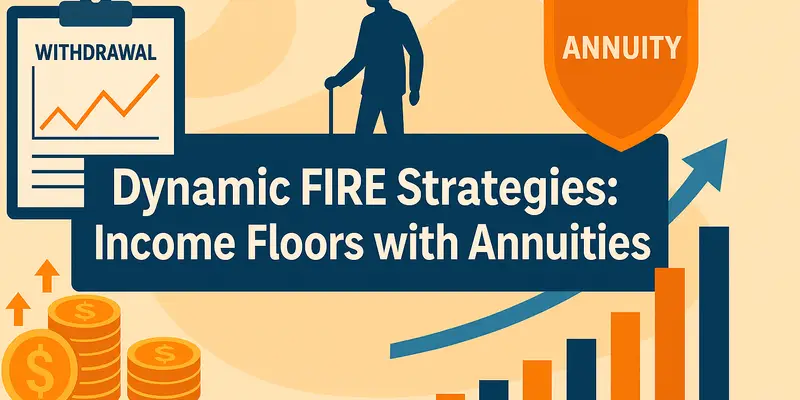Introduction
Early retirement is exhilarating, yet the prospect of sustaining oneself financially for four to five decades can be overwhelming, as even a single market downturn early on has the potential to unravel years of careful planning. Dynamic withdrawal strategies offer a flexible solution, allowing retirees to adjust their spending annually protecting portfolios during bear markets and enabling more generous withdrawals when conditions are favorable. By incorporating annuities into these dynamic plans, retirees can establish a reliable income floor, reduce anxiety and help their portfolios endure through the uncertainties of a long retirement. This article examines how annuities can complement dynamic FIRE withdrawal strategies, creating a balanced and sustainable approach to early retirement.
Key FIRE Withdrawal Challenges
Why static withdrawal rules often fail in FIRE retirements.
Sequence of Returns Risk
One of the greatest dangers for FIRE retirees is poor market performance early in retirement, which can cause lasting damage to their portfolios. Since these individuals may need to support themselves for more than 40 years, a significant market decline—such as a 30% drop in the first two years—could force them to cut spending drastically or risk depleting their assets prematurely. This sequence of returns risk highlights the vulnerability of those relying on static withdrawal rules for long-term financial security.
Longevity and Inflation Uncertainty
Early retirees may require their savings to last for as long as five decades, which makes predicting asset longevity a formidable challenge—especially in the face of rising healthcare expenses. Compounding this uncertainty, inflation gradually erodes purchasing power over time, further intensifying the difficulty of maintaining a sustainable standard of living throughout retirement.
Psychological Factors
Market downturns can push retirees into a state of anxiety, leading them to underspend out of fear, while strong bull markets may encourage excessive withdrawals and overspending. This emotional volatility makes it challenging to adhere to static withdrawal rules. Establishing a reliable income floor can provide stability, ease stress and instilling greater confidence in financial decisions throughout retirement.
Dynamic Withdrawal Strategies Explained
What flexible spending strategies work and why they matter.
Definition
Dynamic withdrawal strategies differ from the traditional fixed 4% rule by adjusting annual withdrawals based on factors like portfolio performance, inflation, and changes in personal circumstances. By remaining flexible and responsive to these variables, dynamic approaches help retirees strike a balance between the risk of outliving their savings and the temptation to underspend, allowing for more secure and adaptable retirement income planning.
Popular Dynamic Strategies
Guyton-Klinger Guardrails:
The Guyton-Klinger Guardrails strategy sets upper (prosperity rule) and lower (capital preservation rule) boundaries for annual withdrawals, allowing spending to increase or decrease only when these thresholds are crossed while also adjusting for inflation. This approach helps create stability in retirement income, minimizing frequent adjustments and providing retirees with a consistent framework for managing their finances through changing market conditions.
Variable Percentage Withdrawal (VPW):
The Variable Percentage Withdrawal (VPW) method involves withdrawing a fixed percentage of the current portfolio value each year. This approach means that annual spending naturally rises in prosperous market years and falls during downturns, allowing retirees to adapt their expenditures to the actual performance of their investments.
Floor-and-Upside Approach:
A floor-and-upside approach involves establishing a base level of guaranteed income—through a combination of annuities, pensions and/or Social Security—to cover essential expenses, while investing the remaining assets for growth. Withdrawals for discretionary spending are then adjusted dynamically, allowing retirees to benefit from market gains without risking their financial foundation during downturns.
| Strategy | Description | Key Features |
|---|---|---|
Guyton-Klinger Guardrails | Sets upper (prosperity rule) and lower (capital preservation rule) boundaries for annual withdrawals, adjusts for inflation. | Stability in income, minimizes frequent adjustments, consistent framework through changing market conditions. |
Variable Percentage Withdrawal (VPW) | Withdraws a fixed percentage of current portfolio value each year. | Spending rises in prosperous years, falls in downturns, adapts expenditures to investment performance. |
Floor-and-Upside Approach | Establishes base guaranteed income (annuities, pensions, Social Security) for essentials, invests remaining assets for growth. | Discretionary withdrawals adjusted dynamically, benefits from market gains, protects financial foundation during downturns. |
FIRE Benefits
By avoiding overspending during market downturns, dynamic withdrawal strategies help extend portfolio longevity and provide a systematic approach to adjusting spending without panic. This empowers FIRE retirees to spend with confidence, secure in the knowledge that their income plan adapts to changing real-world conditions.
Where Annuities Fit In
Integrating guaranteed income into a dynamic strategy.
Why Consider Annuities?
Annuities serve several important roles within a dynamic withdrawal strategy. They provide longevity insurance by ensuring a steady stream of income for life, help buffer the impact of market downturns by reducing the need to sell investment assets at a loss and offer behavioral benefits by creating peace of mind during periods of volatility—especially since they cover essential expenses regardless of market conditions (income floor).
Types of Annuities Relevant to FIRE
Immediate annuities, also known as SPIAs, are designed to start providing income right away or in the near future—making them an ideal choice for those who are already retired and wish to secure core expenses. Deferred income annuities, or DIAs, offer a different approach: they are purchased now but begin delivering income at a later date, such as age 60 or 70, which makes them excellent for addressing late-life financial needs and alleviating concerns about outliving one’s assets (longevity risk). Fixed index annuities (FIAs), meanwhile, combine the potential for modest growth with a degree of downside protection, serving as a conservative anchor within a dynamic withdrawal portfolio.
| Annuity Type | Also Known As | Income Start | Ideal For | Main Features |
|---|---|---|---|---|
Immediate annuities | SPIAs | Right away or soon | Already retired, wish to secure core expenses | Start providing income immediately |
Deferred income annuities | DIAs | Later date (e.g., age 60 or 70) | Late-life financial needs, concerns about outliving assets | Purchased now, income begins later |
Fixed index annuities | FIAs | Not specified | Conservative anchor in withdrawal portfolio | Potential for modest growth, downside protection |
The “Income Floor” Concept
By using annuities to cover essential expenses—much like a pension or Social Security—retirees can establish a stable income floor. This reliable foundation allows the remainder of the portfolio to be managed dynamically and invested for growth, helping to ensure long-term financial security without the fear of running out of money.
Tax Considerations
Non-qualified annuities offer the benefit of tax-deferred growth. For those looking to purchase annuities using qualified accounts, such as IRAs, it’s important to note that these are subject to required minimum distributions (RMDs). Early FIRE retirees should be mindful of potential penalties when withdrawing funds before age 59½, unless they are utilizing non-qualified assets or taking advantage of Substantially Equal Periodic Payments (SEPPs), which can provide exemptions from early withdrawal penalties.
Combining Annuities with Dynamic Withdrawals
Creating a cohesive, sustainable strategy.
Step-by-Step Integration
To build a sustainable retirement strategy, start by identifying your core monthly expenses, such as housing, food, and insurance. Or consider utilizing Dave Ramey’s “four walls” concept to establish your core monthly expenses. Cover these non-negotiable costs with guaranteed income sources like annuities and Social Security to establish a reliable income floor. The remainder of your portfolio can then be managed dynamically using approaches such as Guyton-Klinger guardrails, which help guide discretionary spending. It is important to rebalance your portfolio annually, adjusting your spending and investment allocations in response to market fluctuations and life changes.
| Step | Description | Examples/Approaches |
|---|---|---|
Identify Core Monthly Expenses | Determine essential costs | Housing, food, insurance; Dave Ramey’s “four walls” |
Cover Non-Negotiable Costs | Use guaranteed income sources | Annuities, Social Security |
Manage Remainder Dynamically | Guide discretionary spending | Guyton-Klinger guardrails |
Rebalance Portfolio Annually | Adjust spending and allocations | Respond to market fluctuations and life changes |
Risks and Considerations
Balanced perspective for informed decision-making.
When considering annuities as part of your retirement strategy, it's important to recognize that these products can reduce liquidity since they may tie up a significant portion of your capital—emphasizing the need for maintaining a separate emergency fund. Additionally, fixed annuities might not keep pace with inflation unless you select options with inflation-adjusted riders. Fees and complexity can also be concerns, particularly with variable annuities that include multiple riders, so it's essential to review all associated costs carefully. Finally, always choose annuities from highly rated insurance carriers to ensure the reliability of your future payouts.
Action Steps for FIRE Enthusiasts
Practical next steps to get started.
To get started, run a retirement income projection using both static and dynamic models to understand potential outcomes (Projection Lab would be an example of a good tool to use). Identify your minimum guaranteed income needs and consider matching them with suitable annuity options. As you evaluate products, compare those with low fees and robust guarantees. Finally, consult with a fiduciary to design a tailored, flexible strategy that thoughtfully incorporates annuities into your overall plan.
Conclusion
By utilizing dynamic withdrawal strategies, FIRE retirees can better adapt to shifting market conditions and changing spending needs. Annuities offer a stable foundation, protecting against both longevity risk and the risk associated with market downturns. By thoughtfully blending flexibility with sources of guaranteed income, you can build a retirement plan that supports long-term financial independence, ensuring your needs are met regardless of how the markets perform.




